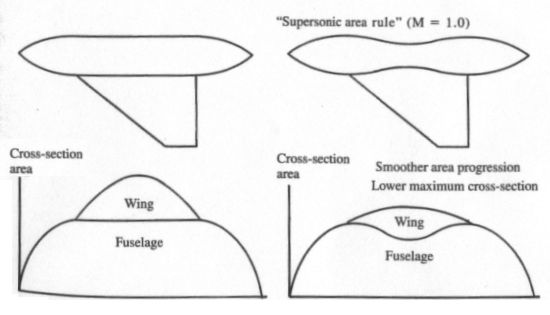|
||||||||||
|
|
||||||||||
|
||||||||||
|
|
||||||||||
Nevertheless, I suspect that the current record holder, even if by the slimmest of margins, is probably the Boeing 747. We have previously discussed an aerodynamic principle called the area rule that describes how to minimize drag on an aircraft flying above Mach 0.8. In simple terms, the area rule states that the shape of the fuselage should be changed from the traditional tubular shape to more of an hourglass shape when the aircraft cruises in the vicinity of Mach 1. When both the fuselage and wing are added together, this layout creates a smooth distribution of the aircraft's cross-sectional area from the nose to the tail, as illustrated below.

This smooth distribution of area minimizes the likelihood of forming shock waves over the surface of the vehicle, which minimizes drag. Now take a look at the layout of the 747 and note the large bulbous region located atop the fuselage forward of the wing. This bulge contains the cockpit and upper passenger deck.

This distinctive "hump" has the effect of giving the 747 fuselage a shape closer to the hourglass contour described
earlier. As a result, the 747 experiences lower drag than a comparable airliner that lacks the bulged fuselage.
The aircraft can therefore travel slightly faster than its competitors for the same amount of fuel. If we compare
the maximum speeds of airliners, we find that the 747 is quoted as being capable of Mach 0.885 whereas most other
airliners can go no faster than Mach 0.87. While the advantage is a small one, it does appear to give the Boeing
747 the distinction of being the fastest commercial airliner in service today.
- answer by Jeff Scott, 16 November 2003
Related Topics:
What is the fastest four-engine propeller-driven plane in the world?
Read More Articles:


|
Aircraft | Design | Ask Us | Shop | Search |

|
|
| About Us | Contact Us | Copyright © 1997- | |||
|
|
|||